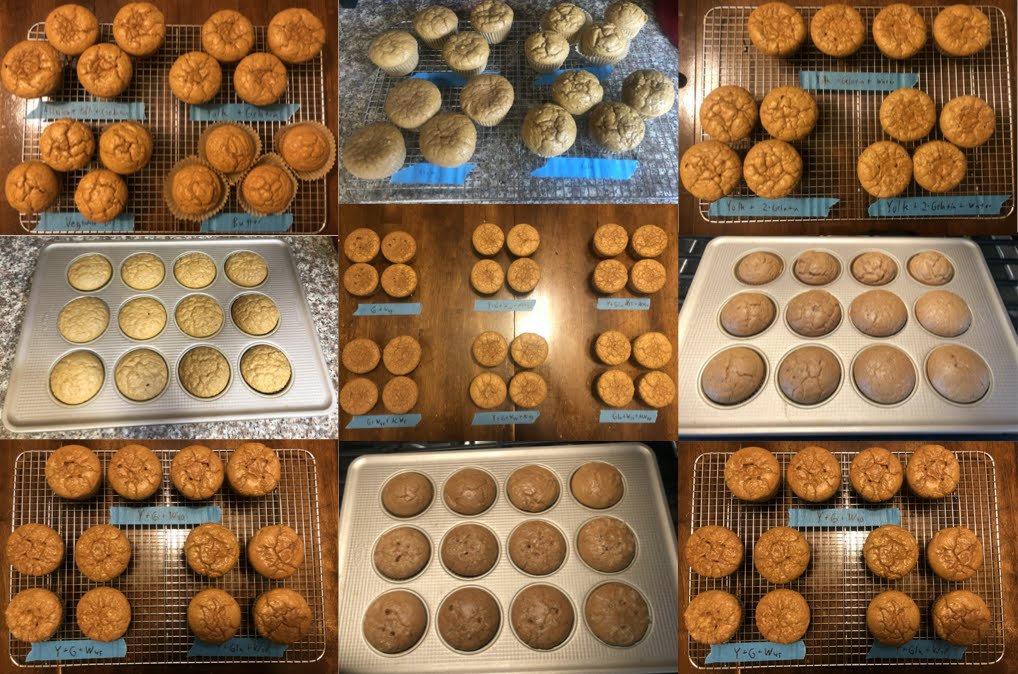
A few months ago, I decided to try eating more protein to help with building muscle.
To avoid significantly increasing my total calories, I first tried just adding protein powder to my breakfast and lunch shakes. That got me the protein I wanted, but it diluted the flavor of the shakes, which I didn’t like.
Next, I tried searching around for a solid low-calorie, high-protein food. Not finding anything, I decided to make my own (still looking, so please comment if you have any suggestions). I started off with a recipe for oat-fiber bread from The Fruit of Her Hands. The oat-fiber, egg white, and glucomannan combination gave me the bulk and texture I wanted with almost no calories.
INITIAL ADAPTATION
To add protein, I substituted whey protein isolate for 36% of the oat-fiber and dropped the cooking time to 18 min. I also swapped cinnamon and liquid sucralose for the onion and garlic powder to make a slightly sweet instead of savory version.
The resulting muffins tasted decent, but the texture was always either a bit too dry or (if I lowered the cooking time) the top center of the muffin was undercooked.
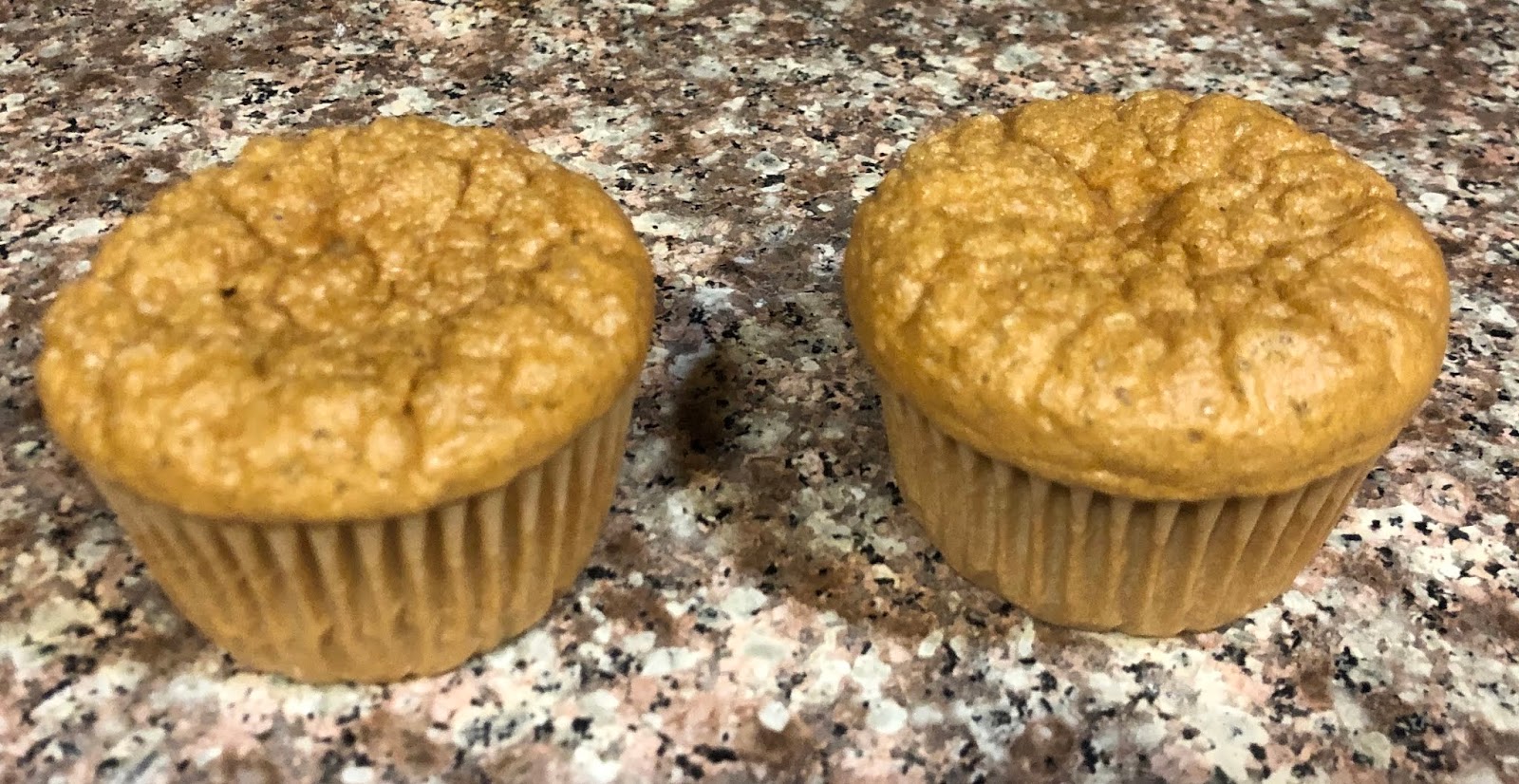
To fix these problems, I tried:
- Increasing cooking time (went from 14 to 19 min. and the muffins went from underdone in the center to too dry, with no happy medium.
- Removed water (much drier).
Other observations:
- The tops of the muffins deflate when they cool. Not a big deal to me, but seemed like a symptom of the texture problem.
- The batter was extremely thin and bubbled more vigorously than a normal muffin batter. Again, not a problem in-and-of-itself, but it made the recipe more time sensitive and made me think something was not quite right.
Round 1: Finding the right ingredients
At this point, I decided to ask for advice on r/ketorecipes. From that post, I got a number of good suggestions, all in the vein of adding an ingredient that either better retains moisture (allulose, gelatin) or one that would coat the oat-fiber to mitigate drying (oil, egg yolk). From these ideas I tried the following experiments:
- All: For all experiments, I removed the water from the recipe, as that made the muffins drier and (I hoped) would make it easier to taste the difference made by the substitutions. I also wanted to increase the density of the muffins.
- Replaced liquid sucralose with 6 tsp. allulose mixed with dry ingredients (suggested by u/NSGod as allulose should retain water and is bulkier)
- Batter: No change in consistency or taste
- Deflation: No change
- Moisture & texture: Perceptibly softer and more moist, but still too dry. Was slightly undercooked in the center of the top.
- Taste: No change
- Added two packets of knox gelatin mixed with dry ingredients (suggested by u/Samr1221 to retain water)
- Batter: Much thicker, similar to a quick-bread batter
- Deflation: Almost none
- Moisture & texture: Even softer and more moist than allulose, but still a bit drier than I’d like. Top was less dry than the bottom.
- Taste: No change
- Added 1 tbsp. commercial ice cream stabilizer mixed with dry ingredients. Same concept as gelatin, but it’s a mix of different thickeners and moisture absorbers, so I thought it’d be interesting to compare.
- Batter: Much thicker, similar to a quick-bread batter
- Deflation: None
- Moisture & texture: Similar moisture to gelatin, but denser and a bit tougher texture.
- Taste: No change
- Added 2 egg yolks (suggested by u/Samr1221 to reduce dry taste, presumably by coating other ingredients)
- Batter: A little thicker, but closer to the original than the gelatin or ice-cream stabilizer
- Deflation: Almost none
- Moisture & texture: Not softer but more moist (in between allulose and gelatin).
- Taste: Subtle improvement in taste (creamier?), but might be in my imagination.
All-in-all, a big improvement. All five changes increased moisture and reduced deflation. If I had to pick one, I’d go with the gelatin, but I figured it could be even further improved.
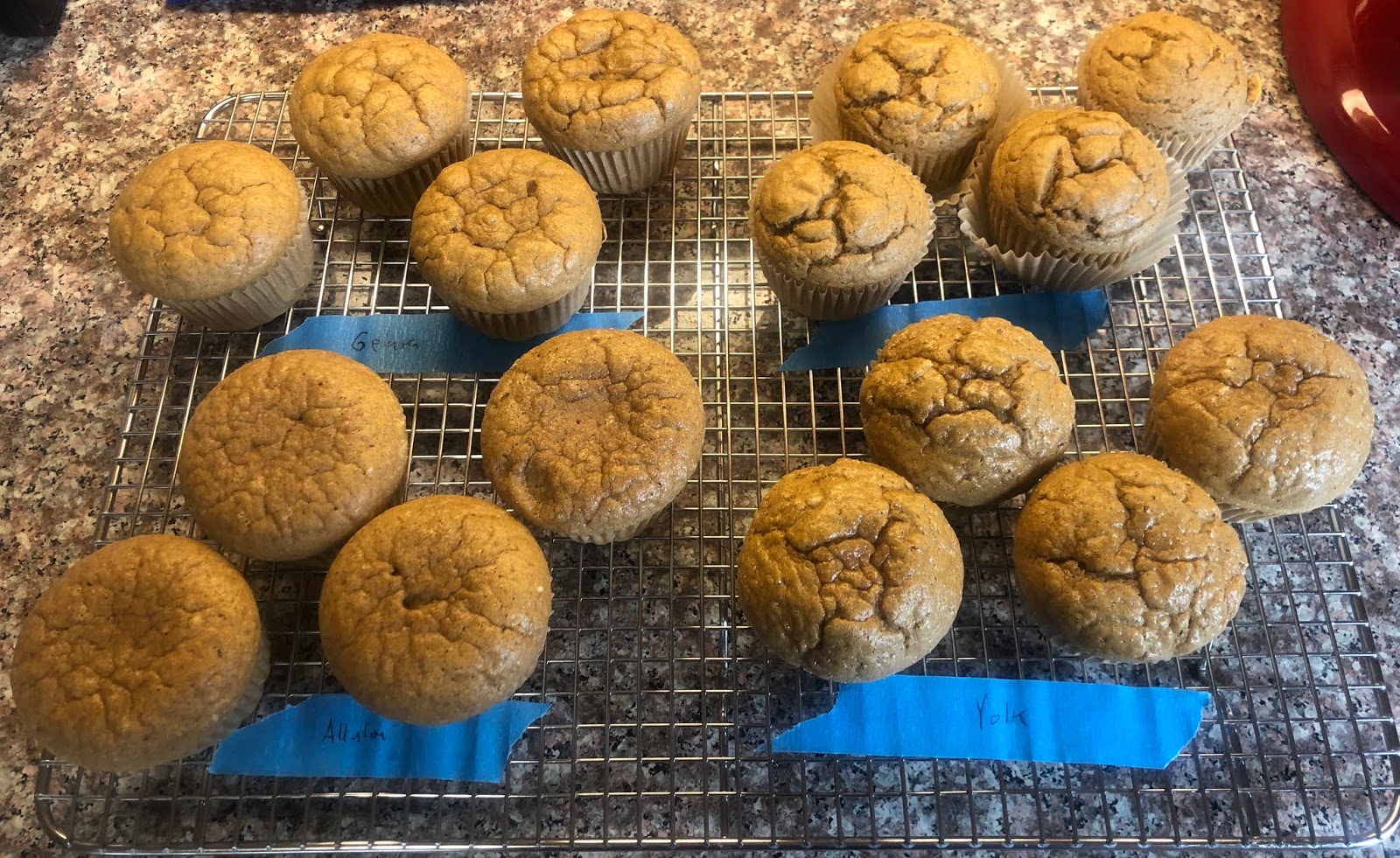
Round 2: Further ingredient screening
With these initial results, I went back to r/ketorecipes for more advice. From that post, the main feedback was to try gluten as a replacement for gelatin or oil/butter instead of or in addition to the egg yolk, so I gave those a shot.
- Added 14 g vital wheat gluten mixed with dry ingredients. Same concept as the gelatin.
- Batter: Slightly thicker
- Deflation: Almost none
- Moisture & texture: In-between allulose and gelatin in moisture, but texture was more bread like.
- Taste: A subtle savory taste that I liked.
- Added 20 g vegetable oil
- Batter: no change
- Deflation: Almost none
- Moisture & texture: In-between allulose and gelatin in moisture, less dry feeling when eating
- Taste: no change
- Added 20 g melted butter
- Batter: much thicker, seemed like the butter may have solidified (egg whites were cold)
- Deflation: Almost none
- Moisture & texture: Much less dry feeling, but the muffins were smaller and too dense. If these had been the same size/texture as the rest, they’d have been great.
- Taste: no change

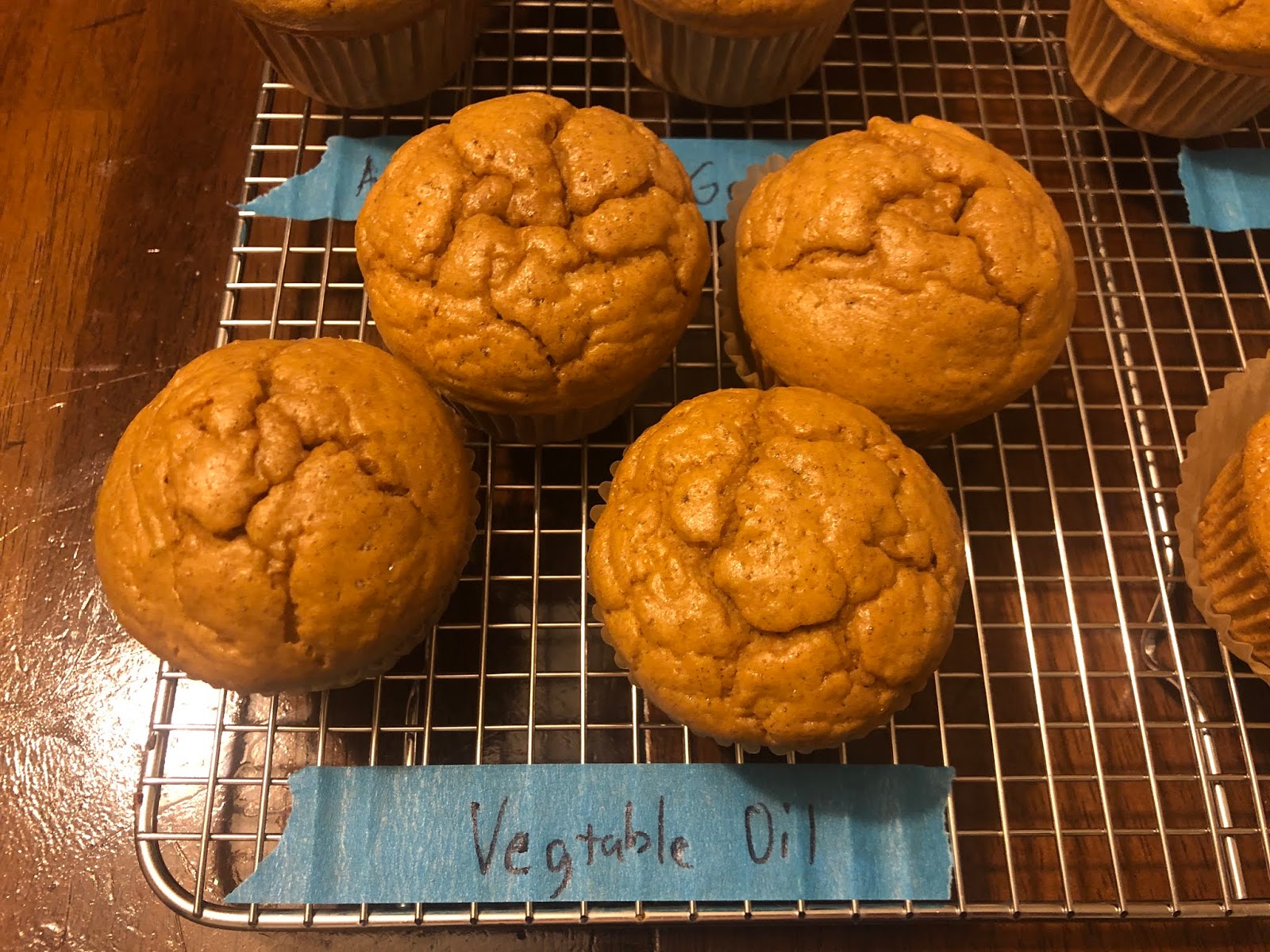
Round 3: Combining changes
From rounds 1 & 2, I was getting significant improvements from allulose, gelatin, egg yolk, gluten, and vegetable oil, but I thought I could do even better by combining them. I didn’t want to add the additional calories from the oil (15 calories/muffin), so I didn’t include that in the combinations.
- 6 tsp. allulose + 2 egg yolk + 2 packets gelatin
- Batter: Slightly thicker, same as just gelatin
- Deflation: Same as just gelatin
- Moisture & texture: Slightly moister than just gelatin.
- Taste: Same subtle creamy texture as when adding egg yolk to the base recipe
- 2 egg yolk + 2 packets gelatin
- Batter: Same as above
- Deflation: Same as above
- Moisture & texture: Slightly less moist than above, but still moister than just gelatin or egg yolk by themselves.
- Taste: Same as above
Based on these results, combining the egg yolk and gelatin seemed worthwhile, but I wasn’t getting much milage out of the allulose. Since I get stomach issues when I eat more than 20-30 g of allulose per day, I decided to keep the liquid sucralose.
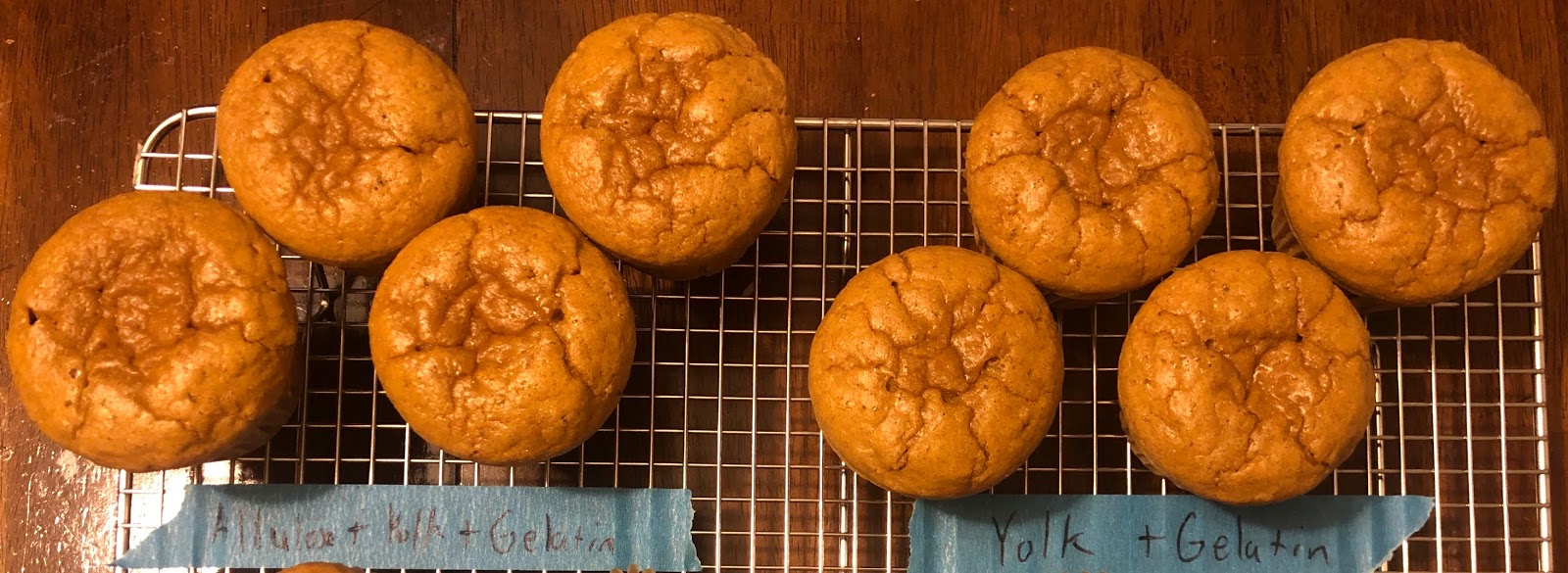
Round 4: Optimizing for taste and convenience
Now that I had the basic ingredients figured out, I did a couple rounds of optimization of quantities. Specifically, I tried to figure out the right amount of gelatin/gluten, water, and seasonings (changes in bold).
- 2 egg yolk + 4 packets gelatin
- Very thick batter, less deflated than 2 packets gelatin, soft & moist, but only slightly more than 2 packets
- 2 egg yolk + 2 packets gelatin + 60 g water
- Thin batter with some deflation. Much more moist and soft. Huge improvement.
- 2 egg yolk + 4 packets gelatin + 120 g water
- Slightly more dense and a bit less “wet” than 2 packets + 60 g water. Very good, but I slightly prefer 2 packets + 60 g water.
- Texture is near perfect, but taste is a bit bland. Needs more seasoning.
- 2 egg yolk + 2 packets gelatin + 60 g water + 1.5 tsp. cinnamon + 2 tbsp. vanilla
- Flavor improved a bit. Still not perfect, but I’m happy with it and don’t want to add more ingredients.
- 2 egg yolk + 2 packets gelatin + 90 g water + 1.5 tsp. cinnamon + 2 tbsp. vanilla
- Slightly thinner batter and more deflation, but moister. I prefer this to the 60 g water.
- 2 egg yolk + 14 g gluten + 60 g water + 1.5 tsp. cinnamon + 2 tbsp. vanilla
- Much thinner batter, more bread-like texture, less “dry” taste, and less wet than gelatin. I prefer the gluten to the gelatin, but it’s a little less convenient and adds a slight amount of carbs (0.15 g/muffin or ~0.5 g per meal for me)
- 0 egg yolk + 2 packets gelatin + 90 g water + 1.5 tsp. cinnamon + 2 tbsp. vanilla
- A little more wet and less creamy/drying vs. with the egg yolk, but it removes an ingredient.
- 0 egg yolk + 2 packets gelatin + 80 g water + 10 g apple cider vinegar + 1.5 tsp. cinnamon + 2 tbsp. vanilla
- This was an attempt to improve the flavor, but ended up with a very interesting effect.
- The muffin had holes riddled throughout the structure (gas generated from vinegar reacting rapidly with baking powder).
- I couldn’t taste the vinegar, but the slight bitter and dry tastes from the oat fiber were completely gone.
- 2 egg yolk + 2 packets gelatin + 80 g water + 10 g apple cider vinegar + 1.5 tsp. cinnamon + 2 tbsp. vanilla
- Indistinguishable from above, so with the apple cider vinegar, the egg yolk no longer has an effect.
- 2 egg yolk + 2 packets gelatin + 50 g water + 40 g apple cider vinegar + 1.5 tsp. cinnamon + 2 tbsp. vanilla
- Slightly denser and chewier than 10 g vinegar. Still no vinegar taste, but I could detect a slight vinegar smell.
- 2 egg yolk + 14 g gluten + 70 g water + 20 g apple cider vinegar + 1.5 tsp. cinnamon + 2 tbsp. vanilla
- Very good taste & texture, but not as large a vinegar effect as with gelatin, probably because the gluten already reduced the bitter and dry tastes.
- 0 egg yolk + 14 g gluten + 70 g water + 20 g apple cider vinegar + 1.5 tsp. cinnamon + 2 tbsp. vanilla
- Slightly more drying than with yolk.
The effect of the apple cider vinegar is extremely interesting, however, I noticed a greater rise in my blood sugar on the days when I ate muffins containing it. That could be a coincidence (it doesn’t contain any carbohydrates), but I need to experiment more before I start using it on a regular basis.
Based on all these experiments my final set of changes from the original recipe are:
- Add 2 packets of gelatin or 14 g gluten
- Reduce water from 180 to 90 g
- Increase cinnamon by 50% and vanilla by 33%
- Add 2 whole eggs & reduce egg whites by 60 g (equivalent to adding 2 egg yolks)
Final Recipe
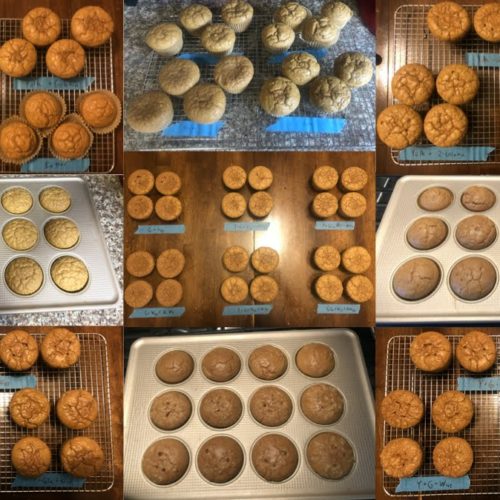
Low-Calorie, High-Protein Oat Fiber Muffin
Ingredients
Base
- 72 g oat fiber
- 40 g whey protein isolate
- 1 tsp salt
- 1 tbsp glucomannan
- 1.5 tsp baking powder
- 2 packets knox gelatin (or 14 g vital wheat gluten)
- 2 large eggs
- 264 g egg whites
- 90 g water
Sweet Flavoring
- 6 drops liquid sucralose
- 2 tbsp vanilla
- 0.5 tbsp cinnamon
Savory Flavoring
- 1.5 tsp garlic powder
- 1.5 tsp onion powder
- 0.5 tsp chili powder (optional)
- 7.5 g nutritional yeast (optional)
Instructions
- Preheat oven to 350 °F.
- Whisk together wet and dry ingredients in separate bowls, then combine and mix until fully incorporated.
- Transfer to parchment-lined muffin pans (8-12 muffins) and bake for 18 min.
- Cool completely before eating. Can be stored in a sealed container for at least 4 days (haven’t tried longer).
have you tried casein protein?
This is remarkable!!! You are remarkable. Just found this site. Are you still writing? I was looking for more recent posts